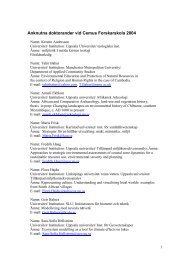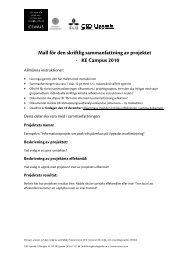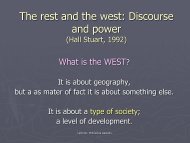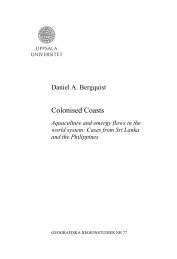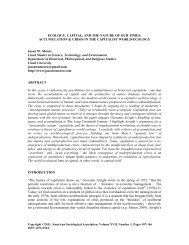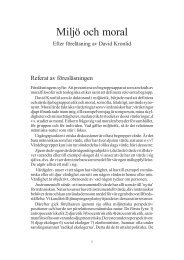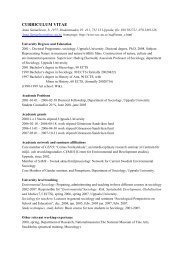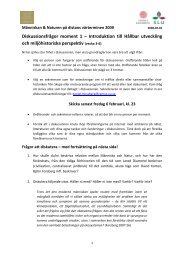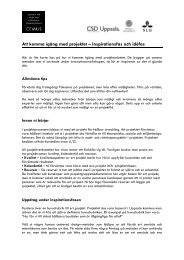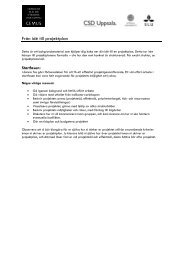Benefits of genetically modified crops for the poor - entsteht die ...
Benefits of genetically modified crops for the poor - entsteht die ...
Benefits of genetically modified crops for the poor - entsteht die ...
Create successful ePaper yourself
Turn your PDF publications into a flip-book with our unique Google optimized e-Paper software.
REVIEW New Biotechnology Volume 27, Number 5 November 2010ReviewIn a next step, present b-carotene intakes from nationally representativefood consumption data were derived and <strong>the</strong> likely shiftin <strong>the</strong> intake distribution through future consumption <strong>of</strong> GoldenRice was established. This required assumptions which were basedon experimental data and expert estimates about <strong>the</strong> technology’sefficacy and future coverage. Higher b-carotene intakes willimprove <strong>the</strong> vitamin A status <strong>of</strong> individuals, thus reducing <strong>the</strong>incidence <strong>of</strong> adverse health outcomes. These new incidence rateswere derived and used to re-calculate <strong>the</strong> expected remainingburden with Golden Rice. The difference in <strong>the</strong> disease burdenwith and without Golden Rice is <strong>the</strong> expected impact <strong>of</strong> <strong>the</strong>technology expressed in terms <strong>of</strong> <strong>the</strong> number <strong>of</strong> DALYs saved.According to <strong>the</strong>se calculations, <strong>the</strong> current annual diseaseburden <strong>of</strong> VAD in India amounts to a loss <strong>of</strong> 2.3 million DALYs,<strong>of</strong> which 2.0 million is lost due to child mortality alone. In terms <strong>of</strong>incidence numbers, more than 70,000 Indian children under <strong>the</strong>age <strong>of</strong> six <strong>die</strong> each year due to VAD. In this context, widespreadconsumption <strong>of</strong> Golden Rice could reduce <strong>the</strong> burden <strong>of</strong> VAD by59%, which includes <strong>the</strong> saving <strong>of</strong> almost 40,000 lives each year(Table 4). Because <strong>the</strong> severity <strong>of</strong> VAD is negatively correlated withincome, <strong>the</strong> positive effects are most pronounced in <strong>the</strong> <strong>poor</strong>estincome groups.While <strong>the</strong>se results suggest that Golden Rice alone is unlikely toeliminate <strong>the</strong> problems <strong>of</strong> VAD, <strong>the</strong> projected improvements inpublic health and nutrition are huge. Similar effects can also beexpected in o<strong>the</strong>r rice-eating countries with a high prevalence <strong>of</strong>VAD. Beyond <strong>the</strong> reduction in health costs and individual suffering,nutritional improvements are associated with positiveimpacts on labour productivity. Anderson et al. [25] used a macroeconomicmodel to simulate <strong>the</strong> benefits <strong>of</strong> Golden Rice at <strong>the</strong>global level. Modelling consumer nutrition and health effectsamong <strong>the</strong> <strong>poor</strong> as an increase in <strong>the</strong> productivity <strong>of</strong> unskilledlabourers, <strong>the</strong>y estimated worldwide welfare gains <strong>of</strong> over 15billion US$ per year, with most <strong>of</strong> <strong>the</strong> benefits accruing in Asia.TABLE 4Burden <strong>of</strong> vitamin A deficiency in India and potential impact <strong>of</strong>Golden Rice.Current burden <strong>of</strong> vitamin A deficiencyNumber <strong>of</strong> DALYs lost each year (thousands) 2,328Number <strong>of</strong> lives lost each year (thousands) 71.6Potential impact <strong>of</strong> Golden RiceNumber <strong>of</strong> DALYs saved each year (thousands) 1382Reduction <strong>of</strong> <strong>the</strong> DALYs burden (%) 59.4Number <strong>of</strong> lives saved each year (thousands) 39.7Cost-effectiveness <strong>of</strong> Golden Rice and o<strong>the</strong>rvitamin A interventionsCost per DALY saved through Golden Rice (US$) 3.1World Bank cost-effectiveness standard200<strong>for</strong> DALYs saved (US$)Cost per DALY saved through supplementation (US$) 134Cost per DALY saved through industrial84<strong>for</strong>tification (US$)Note: The impact estimates reported here build on <strong>the</strong> ‘high impact scenario’ in [24]. Givenrecent evidence about <strong>the</strong> high efficacy <strong>of</strong> Golden Rice [27] <strong>the</strong> assumptions in that scenarioappear realistic when <strong>the</strong> technology receives public support <strong>for</strong> social marketing ef<strong>for</strong>ts.Source: [24].In China, <strong>for</strong> instance, Golden Rice is projected to entail a 2%growth in national income [25].Cost-effectivenessThe high expected effectiveness <strong>of</strong> Golden Rice in reducing <strong>the</strong>problems <strong>of</strong> VAD was shown in <strong>the</strong> previous subsection. Thiscertainly is a cause <strong>for</strong> optimism. However, from an economicperspective it needs to be asked at what cost a certain effect isachieved. The major costs <strong>of</strong> Golden Rice are <strong>the</strong> investments inresearch as well as in developing, testing and disseminating <strong>the</strong>GM technology. Dividing <strong>the</strong>se costs by <strong>the</strong> number <strong>of</strong> DALYssaved, and taking into account <strong>the</strong> time when costs and benefitsoccur through discounting, results in <strong>the</strong> average cost per DALYsaved, which is a common measure <strong>for</strong> <strong>the</strong> cost-effectiveness <strong>of</strong>health interventions. This was done by Stein et al. [24] in <strong>the</strong>iranalysis <strong>for</strong> Golden Rice in India. According to <strong>the</strong>ir projections,<strong>the</strong> cost per DALY saved through Golden Rice is in a magnitude <strong>of</strong>3 US$ (Table 4), which is very low. A sensitivity analysis showedthat, even with much more pessimistic assumptions, <strong>the</strong> costwould not rise to more than 20 US$ per DALY saved.These results should be compared with suitable benchmarks. TheWorld Bank classifies health interventions as very cost-effectivewhen <strong>the</strong>ir cost is less than 200 US$. This underlines that GoldenRice could be extremely cost-effective. But how does Golden Ricecompare with conventional vitamin A interventions? Scaling upfood supplementation or industrial <strong>for</strong>tification programs <strong>for</strong> vitaminA in India would cost between 84 and 134 US$ per DALY saved(Table 4). The major cost <strong>of</strong> <strong>the</strong>se conventional interventions is notto produce <strong>the</strong> vitamin pills or food <strong>for</strong>tificants, but to reach <strong>the</strong>target population in remote rural areas, which requires large investmentsand monitoring on a regular basis. This is different <strong>for</strong> GoldenRice: even though <strong>the</strong> initial investment is high, recurrent costs willbe low, because Golden Rice seeds will spread through existing<strong>for</strong>mal and in<strong>for</strong>mal distribution channels and can be reproducedby farmers <strong>the</strong>mselves. None<strong>the</strong>less, possible issues <strong>of</strong> consumeracceptance must be considered, and suitable strategies to convincefarmers to adopt Golden Rice varieties have to be developed. Acombination <strong>of</strong> b-carotene with interesting agronomic traits in ricemight be a practicable avenue.In spite <strong>of</strong> <strong>the</strong> high projected cost-effectiveness, Golden Riceshould not be seen as a substitute <strong>for</strong> existing vitamin A interventions,but as a complementary strategy. No single approach willeliminate <strong>the</strong> problem <strong>of</strong> VAD and all interventions have <strong>the</strong>irstrengths and weaknesses in particular situations. While supplementationand industrial <strong>for</strong>tification might be more suitable <strong>for</strong>urban areas and feeding programs <strong>for</strong> well-defined target groups,Golden Rice is likely to achieve a wider coverage, <strong>for</strong> example inremote rural areas. It is only in <strong>the</strong> long run that poverty reductionand economic growth may be expected to contribute to <strong>die</strong>tarydiversification, which might <strong>the</strong>n reduce <strong>the</strong> urgency <strong>for</strong> morespecific micronutrient interventions.ConclusionGM <strong>crops</strong> are not a magic bullet against all problems in developingcountries, but <strong>the</strong>y hold significant potential to contribute topoverty reduction, better nutrition and health, and sustainabledevelopment. Some <strong>of</strong> <strong>the</strong>se potentials have already materialised.Yet it should be stressed that GM technologies can be very diverse,556 www.elsevier.com/locate/nbt



